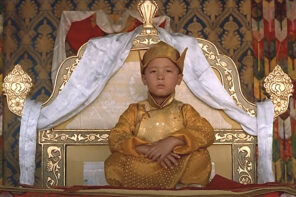Hey, college educated women who are rejecting the Republican nominee by historic margins, fueling a 16-point lead for Hillary Clinton with this key demographic, it turns out that, according to New York Times columnist Ross Douthat, the lousy choices available to us on election day are all our fault. And you’ll never guess why: because we didn’t have enough babies to keep men from feeling sad and lonely.
Yup, both Hillary Clinton and the entire Trump phenomenon (the specter of an actual demagogue taking the reins of the most powerful nation on earth, finger on the nukes) are due to the decline in childbearing, says Douthat. You see, Douthat’s great-grandfather had five children, as did his grandfather, and things were good and men were happy. But then, it all went off the rails:
Then the social revolutions of the 1970s arrived. There were divorces, later marriages, single parenthood, abortions. In the end all those aunts and uncles, their various spouses and my parents—12 baby boomers, all told—only had seven children …
Everywhere across the developed world, families have grown more attenuated: fewer and later marriages, fewer and later-born children, fewer brothers and sisters and cousins, more people living longer and longer stretches on their own. It’s a new model of social life, a ‘post-familial’ revolution that’s unique to late modernity.
What does this have to do with the election? Glad you asked:
Human beings imagine and encounter the future most intensely through our own progeny … but when people think about the undiscovered America of the future, its strongest claim on them is one their own descendants make.
If those descendants exist. But for many native-born Americans there are fewer of them—fewer children and, as birthrates drop and marrying age rises, still-fewer grandchildren or none at all.
This, in turn, says Douthat, has created a sense of alienation that is only further fueled by the decline of working-class communities and gives rise to “a grim vision of the future, in which after you’ve passed, your few kids and grandkids will be beset, isolated and alone.” It’s this “sense of dread” that “bleeds easily into ethno-racial anxiety” that has fueled the rise of Trump, offering “tribal solidarity to people whose family bonds have frayed.”
While Douthat is careful to avoiding naming names, it’s clear who’s responsible for all these lonely grandparents: women who insist on employing birth control and abortions to have small families. Clearly, if women, especially educated women, would just go back to having 13 children, like the Pittsburgh-area woman in the 1940s photo that helpfully illustrates Douthat’s column, we wouldn’t have to worry about Donald Trump.
There are just a few problems with Douthat’s hypothesis. For starters, while Douthat buys into the conservative fantasy that shrinking families are “unique to late modernity,” that’s not true. In fact, the largest decline in U.S. family size occurred during the nineteenth century. The average woman went from bearing about seven or eight children in 1800, to between three and four by 1900, in tandem with the industrial revolution.
And among the native-born white population that Douthat is so concerned about, average family size was even smaller. A two-child family was already the norm for many middle and upper-middle class Protestant women, leading men like Theodore Roosevelt to decry “race suicide” and the “base and selfish doctrine” of keeping families small to provide more opportunity for fewer children.
What’s more, family size shrank and expanded throughout the twentieth century. During the depression, average family size shrank to about two children; families began to grow with post-war prosperity, reaching an average of just under four children by 1957. This era of big families, however, was something of an anomaly in the twentieth century, not, as Douthat suggests, an historical norm. And when family size does decline, as it did during the Depression, the oil crisis of the 1970s, and following the Republican-led 2008 financial crash, it’s often due to economic uncertainty.
Secondly, if smaller families are fueling a massive sense of isolation and social dislocation among Trump supporters, how come the college-educated coastal elites whom Douthat is so fond of criticizing don’t share the same doom-and-gloom despite their petite family sizes?
The answer is that the sense of limited possibilities and social ennui experienced by Trump supporters, while real, isn’t a result of small families. It’s a result of the collapse of the industrial sector and the loss of well-paying, blue collar jobs—a decline caused in no small part by free-trade and winner-take-all policies supported by the Republican Party.
Take, for instance, Monessen, Pennsylvania, the once-vibrant steel city about 30 miles south of Pittsburgh visited by Trump with great fanfare in June to announce his “plan” to rebuild the manufacturing base. In 1940, the city had a population of about 20,000 people; in 1990, it was about 13,000. Today, the population stands about 7,000 and shrinking. The city itself looks like something out of a “Walking Dead” set—and that’s not just because the only viable concern in the city is a special effects monster-make-up school.
The city itself is literally rotting. Small trees sprout from crumbling brick buildings that line downtown streets that once thrummed with people. The modest wood-frame houses in the neighborhood that once abutted the Wheeling & Pittsburgh Steel mill are rotting, overgrown with ivy and weeds, and largely abandoned. Just outside the largely deserted downtown, in the slightly more prosperous suburban areas, Trump/Pence signs sprout on lawns as they do throughout much of this part of Pennsylvania.
There’s no doubt that family patterns have changed in hard-pressed areas like Monessen. Lower middle-class areas have seen a rise in out-of-wedlock births and there is a declining, aging population. But the depopulation of areas like Monessen aren’t due primarily to a decrease in family size. Much of the decline can be traced to the 1970s and 1980s, when the steel plants closed. Wheeling & Pittsburgh Steel, where my father-in-law worked for 35 years, was shuttered in 1986, taking most of the jobs with it. Three of his four sons went to college and left the area, like most of their classmates, because it held little promise for the future even 30 years ago. Two of the three had children—eight in all—just not in Monessen.
The story of Monessen is writ large in its Catholic churches. Monessen once boasted five substantial Catholic churches: St. Leonard’s, which was the Irish church; Most Holy Name of Jesus, which was Slovak; St. Cajetan, which was Italian; St. Hyacinth, which was Polish, and St. Anthony, which was Croatian. As the city’s population shrank, the five were eventually consolidated into one new parish, Epiphany of the Lord, which serves mostly aging parishioners. But that consolidation occurred 25 years ago. Monessen, like much of the Rust Belt, has been living in Douthat’s “post-familial” society for decades.
Rather than conveniently blaming women and reproductive emancipation—which Douthat doesn’t approve of anyway—for the rise of Trump, he might want to look at his own party, which in addition to ushering blue-collar work out the door has long humored an increasingly vile strain of far-right, do-nothing conservatism that has stoked anger and despair among the left-behind working class.
As the Dalai Lama and Arthur Brooks wrote recently, the answer to the despair sweeping through increasingly superfluous working-class communities is both spiritual and temporal. What’s needed, they say, is a concerted effort to “create a wealth of opportunities for meaningful work, so that everyone who is capable of contributing can do so.” Telling people “you should have had more children when you had the chance,” which even Douthat admits isn’t palatable, when there are no jobs to provide for these children, is just ideological cruelty.





